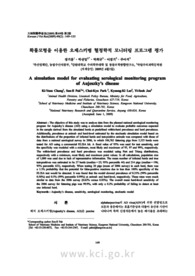

PARTNER
검증된 파트너 제휴사 자료
확률모형을 이용한 오제스키병 혈청학적 모니터링 프로그램 평가 (A simulation model for evaluating serological monitoring program of Aujeszky’s disease)
7 페이지
최초등록일 2025.05.11
최종저작일
2009.06

-
미리보기
서지정보
· 발행기관 : 대한수의학회
· 수록지 정보 : 대한수의학회지 / 49권 / 2호 / 149 ~ 155페이지
· 저자명 : 장기윤, 박선일, 박최규, 이경기, 주이석
초록
The objective of this study was to analyze data from the planned national serological monitoring program for Aujeszky’s disease (AD) using a simulation model to evaluate probable outcomes expected in the sample derived from the simulated herds at predefined within-herd prevalence and herd prevalence. Additionally, prevalence at animal- and herd-level estimated by the stochastic simulation model based on the distributions of the proportion of infected herds and test-positive animals was compared with those of data from a national serological survey in 2006, in which 106,762 fattening pigs from 5,325 herds were tested for AD using a commercial ELISA kit. A fixed value of 95% was used for test sensitivity, and the specificity was modeled with a minimum, most likely and maximum of 95, 97 and 99%, respectively. The within-herd prevalence and herd prevalence was modeled using Pert and Triang distributions, respectively with a minimum, most likely and maximum point values. In all calculations, population size of 1,000 was used due to lack of representative information. The mean number of infected herds and true test-positives was estimated to be 27 herds (median = 25; 95% percentile 44) and 214 pigs (median = 196; 95% percentile 423), respectively. When testing 20 pigs (mean of 2006 survey) in each herd, there was a 3.3% probability that the potential for false-positive reactions due to less than 100% specificity of the ELISA test would be detected. It was found that the model showed prevalence of 0.21% (99% percentile 0.50%) and 0.5% (99% percentile 0.99%) at animal- and herd-level, respectively. These rates were much similar to data from the 2006 survey (0.62% versus 0.83%). The overall mean herd-level sensitivity of the 2006 survey for fattening pigs was 99.9%, with only a 0.2% probability of failing to detect at least one infected herd.영어초록
The objective of this study was to analyze data from the planned national serological monitoring program for Aujeszky’s disease (AD) using a simulation model to evaluate probable outcomes expected in the sample derived from the simulated herds at predefined within-herd prevalence and herd prevalence. Additionally, prevalence at animal- and herd-level estimated by the stochastic simulation model based on the distributions of the proportion of infected herds and test-positive animals was compared with those of data from a national serological survey in 2006, in which 106,762 fattening pigs from 5,325 herds were tested for AD using a commercial ELISA kit. A fixed value of 95% was used for test sensitivity, and the specificity was modeled with a minimum, most likely and maximum of 95, 97 and 99%, respectively. The within-herd prevalence and herd prevalence was modeled using Pert and Triang distributions, respectively with a minimum, most likely and maximum point values. In all calculations, population size of 1,000 was used due to lack of representative information. The mean number of infected herds and true test-positives was estimated to be 27 herds (median = 25; 95% percentile 44) and 214 pigs (median = 196; 95% percentile 423), respectively. When testing 20 pigs (mean of 2006 survey) in each herd, there was a 3.3% probability that the potential for false-positive reactions due to less than 100% specificity of the ELISA test would be detected. It was found that the model showed prevalence of 0.21% (99% percentile 0.50%) and 0.5% (99% percentile 0.99%) at animal- and herd-level, respectively. These rates were much similar to data from the 2006 survey (0.62% versus 0.83%). The overall mean herd-level sensitivity of the 2006 survey for fattening pigs was 99.9%, with only a 0.2% probability of failing to detect at least one infected herd.참고자료
· 없음태그
-
자주묻는질문의 답변을 확인해 주세요

꼭 알아주세요
-
자료의 정보 및 내용의 진실성에 대하여 해피캠퍼스는 보증하지 않으며, 해당 정보 및 게시물 저작권과 기타 법적 책임은 자료 등록자에게 있습니다.
자료 및 게시물 내용의 불법적 이용, 무단 전재∙배포는 금지되어 있습니다.
저작권침해, 명예훼손 등 분쟁 요소 발견 시 고객센터의 저작권침해 신고센터를 이용해 주시기 바랍니다. -
해피캠퍼스는 구매자와 판매자 모두가 만족하는 서비스가 되도록 노력하고 있으며, 아래의 4가지 자료환불 조건을 꼭 확인해주시기 바랍니다.
파일오류 중복자료 저작권 없음 설명과 실제 내용 불일치 파일의 다운로드가 제대로 되지 않거나 파일형식에 맞는 프로그램으로 정상 작동하지 않는 경우 다른 자료와 70% 이상 내용이 일치하는 경우 (중복임을 확인할 수 있는 근거 필요함) 인터넷의 다른 사이트, 연구기관, 학교, 서적 등의 자료를 도용한 경우 자료의 설명과 실제 자료의 내용이 일치하지 않는 경우
“대한수의학회지”의 다른 논문도 확인해 보세요!
-
고양이의 땀샘 선암종 증례 5 페이지
A 11-year-old female mixed cat with subcutaneous mass around the left 5th mammary glands was presented to local animal hospital. According to history taking, the mass recurred 2 times on the same site.. -
브루셀라병 감염소 사체처리 방법별 절차 및 소요비용 비교: 매몰, 재활용, 소각 7 페이지
In Korea, burial is the most common method of disposing animal carcasses culled due to brucellosis infection. However, burial has many disadvantages such as shortage of appropriate burial sites, possi..
문서 초안을 생성해주는 EasyAI
